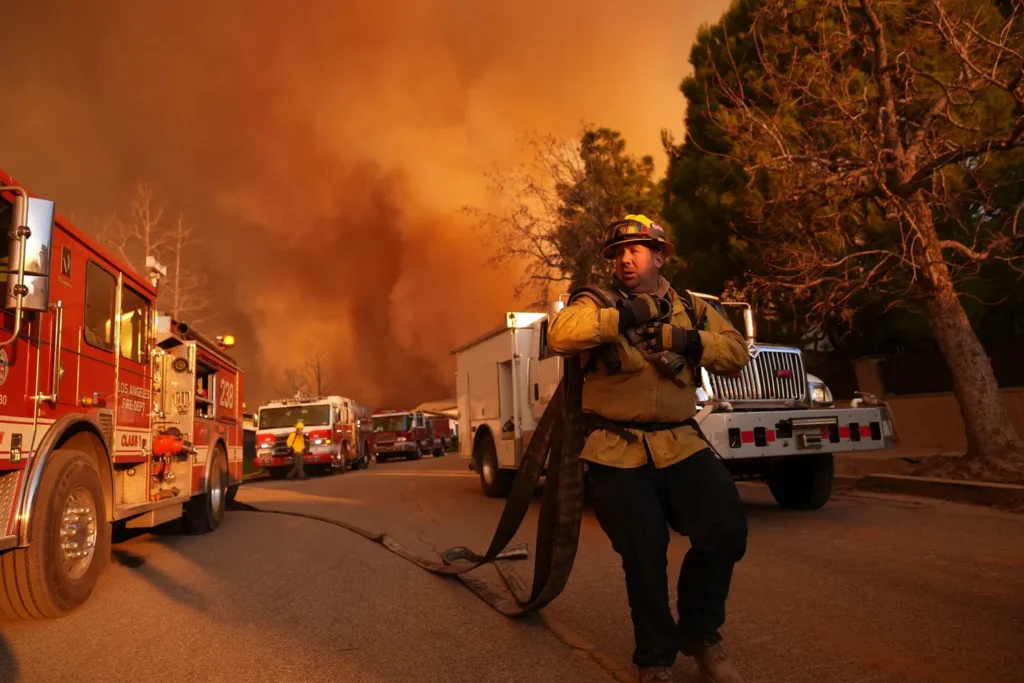The recent wildfires in Los Angeles have been attributed to a combination of natural and human-induced factors. Key contributors include:
- Drought Conditions: Southern California has experienced severe drought, leading to dry vegetation that serves as fuel for wildfires. Climate change has intensified these conditions, creating volatility in rainfall and extending dry seasons.
- Santa Ana Winds: Strong Santa Ana winds have exacerbated the fires by spreading flames rapidly and grounding firefighting aircraft.
- Potential Ignition Sources: Investigations are ongoing, but possible causes include power grid faults, debris burning, fireworks, and utility lines. For instance, the Palisades Fire may have been re-ignited by remnants of a previous blaze believed to have been sparked by New Year’s Eve fireworks.
- Climate Change: Rising global temperatures have increased wildfire risks, making them a year-round threat in California. Climate change has also led to hydroclimate volatility, with periods of heavy rain followed by drought, resulting in abundant vegetation that dries out and becomes fuel for fires.
These factors, combined with challenges such as budget cuts to fire departments and maintenance issues affecting water supplies, have contributed to the severity of the wildfires in Los Angeles.

What Was the Reason Behind Los Angeles Wildfires and What Caused Them?
The Los Angeles wildfires, like many wildfires in Southern California, are the result of a complex interplay of natural factors, human activity, and environmental changes. Below is a detailed exploration of the causes behind these destructive events:
1. Climate Change and Rising Temperatures
Global warming has led to significant shifts in weather patterns, particularly in California. Over the past few decades, temperatures have risen, leading to:
- Longer Fire Seasons: Historically, wildfires were more common during the late summer and early autumn. However, due to warmer temperatures year-round, fire season now lasts longer.
- Drier Conditions: Warmer weather leads to increased evaporation, which dries out soil and vegetation, creating perfect conditions for wildfires.
- Extreme Weather Events: Climate change has made weather patterns more volatile, with intense heat waves further increasing wildfire risks.
2. Drought and Dry Vegetation
California has faced recurring droughts over the years, severely impacting its ecosystem. These droughts dry out vegetation, turning plants, grass, and trees into highly flammable material.
- Fuel Accumulation: With little rainfall to support healthy vegetation, plants dry out and accumulate as tinder.
- Hydroclimate Variability: Heavy rains during some seasons promote vegetation growth, but when followed by long dry periods, this abundant plant life becomes fuel for wildfires.
3. Santa Ana Winds
Santa Ana winds are powerful, dry winds that blow from inland deserts toward the coast. These winds play a critical role in spreading wildfires.
- Rapid Spread: The winds can carry embers over long distances, igniting new fires far from the original blaze.
- Increased Intensity: Strong gusts fan the flames, making them burn hotter and spread faster.
- Challenges to Firefighting: These winds also make aerial firefighting efforts challenging, grounding planes and helicopters during critical moments.
4. Human Activities
Human activities are one of the leading causes of wildfires in California, contributing to ignition and spread.
- Utility Lines and Equipment Failures: Faulty power lines or transformers often spark fires, especially during windy conditions.
- Debris Burning: Improperly managed campfires, burning of trash, or agricultural debris can start wildfires.
- Fireworks and Celebrations: Events involving fireworks, such as New Year’s Eve, have been linked to wildfire outbreaks.
- Arson: Intentional setting of fires remains a concerning cause of wildfires in urban and wildland areas.